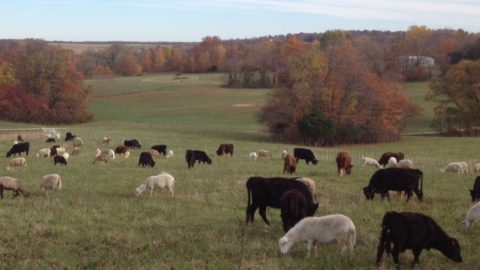Larry’s Story
I just returned from two days of hands-on training for hog butchering at Purdue’s experiential learning center on its West Lafayette campus.
In two days, four class participants killed fourteen hogs. We processed six or seven of them into retail cuts. The Purdue team was friendly, helpful and extremely gracious in sharing their knowledge.
The Debate
As with all such events where small producers and home preppers meet conventional academics, there was some good back and forth on the topics of “natural” or “small scale” versus “conventional” or “industrial” agriculture.
One discussion rehashed some arguments from both sides of the debate about the differences between food from organic and regenerative practices versus the mainstream food system. Our host insisted that the science is settled in showing that organic and pasture-raised foods are no different in substance or nutrition from conventionally produced foods. I didn’t attempt to destroy her arguments with counter-evidence but rather focused on some points that I hope will lead to a change in perspective.
In particular, I emphasized that we (especially scientists) might be more humble in making conclusions given that we frequently examine only a very thin slice of reality at once. I used the example of putting lime on a field to improve fertility and how futile it is without the tiniest amounts of certain trace minerals, like boron, to make that lime bioavailable. If this is true, I argued, the same could be true of nutrient availability in the human body. That is, two carrots might have the same macronutrient composition but one might have the presence of important trace nutrients (or even microbial content) essential for proper absorption and use by the body.
Our host also discussed the issue of Omega-3 versus Omega-6 fatty acids in grassfed beef.
Details / Schmetails (are important!)
I’d like to both share our host’s arguments and provide you with a more complete rebuttal because I think it’s important for all of us to be able to counter these narratives with good arguments, or at least ask questions to make people rethink their positions.
First, regarding the claim that there is no difference in nutrient content, I’d make the following points:
o They contradict their own point by admitting that grass-fed beef **does** have a ratio of 3:1 or 2:1 of Omega 6 to Omega 3 while grain-fed beef has anywhere from 15:1 to 23:1 or higher. However, they try to dismiss the significance of that… (see below for details).
Proponents of pasteurized dairy do much the same when they admit that cooking milk destroys its Vitamin C content. “Who needs to get vitamin C from milk” they say, “You can get much more than that in a pill or from an orange.” But this ignores the fact that vitamin C is much more than just ascorbic acid and that it needs to be provided in the milk in order to counter milk’s otherwise mucilaginous effects.
o Furthermore, we know from lab testing that eggs raised on pasture have up to seven hundred percent more nutrients in certain categories. See here and here.
o There is no debate that nutrient content of most vegetables has measurably and significantly decreased since the 1950s due to soil nutrient depletion. If organic vegetables are not measuring higher in nutrients, it could be because the growers are not truly using organic methods to improve soil health. This practice is referred to as “organic by neglect” or when produce is grown only without biocides but nothing is done to improve the soil. This is not truly “organic” and it highlights the importance of measuring the quality of your organic vegetables or, better yet, knowing your source and their soil improvement measures.
“A landmark study on the topic by Donald Davis and his team of researchers from the University of Texas (UT) at Austin’s Department of Chemistry and Biochemistry was published in December 2004 in the Journal of the American College of Nutrition. They studied U.S. Department of Agriculture nutritional data from both 1950 and 1999 for 43 different vegetables and fruits, finding “reliable declines” in the amount of protein, calcium, phosphorus, iron, riboflavin (vitamin B2) and vitamin C over the past half century. ” (Link)
o Finally, new nutrition studies comparing grass-fed versus grain-fed are looking at a much broader spectrum of nutrients and are finding:
Grain-finished beef has:
- More inflammatory markers
- Higher uric acid levels
- Higher homocysteine levels
- Higher advanced glycated end products
- Higher amounts of niacinamide (a form of vitamin B3 found in supplements)
Grass-finished beef has:
- Higher omega-3 fatty acids (DHA and EPA)
- Higher amount of phytonutrients
- Higher microbial diversity
- Higher amounts of niacin (a natural form of vitamin B3)
- Higher vitamin C levels
- Higher vitamin E levels
- Higher antitumor biomarkers
- Higher choline
- Higher carnosine
Basically, the grass-fed animals have muscle comparable to an athlete while the grain-fed animal has muscle comparable to a person with metabolic syndrome.
One Down, One to Go
So, it’s simply not correct to say that there is no difference between these products. Clearly there is a difference and they admit just that in certain cases like raw versus pasteurized milk and grassfed versus grain-fed beef. Then, they try to explain away the differences as being inconsequential. Here’s their argument (as retold by our Purdue host — paraphrased of course):
“Grassfed does have a different ratio of Omega 6 to Omega 3 but it doesn’t matter because the amounts of Omega 3 are still so low compared to, say, salmon. For instance, salmon might have 300 milligrams of Omega-3 fatty acids whereas grassfed beef might have just 3 milligrams or even 0.3 milligrams. So, you are better off just eating the salmon. AND on top of that, there is more fat on grain-fed beef than on grassfed, so the overall amount of Omega 3 that you get when eating grain-fed is actually higher than eating grassfed.”
Sounds good, right? Wrong. Here’s the problem. The scientific literature confirms that mammals in the wild, including herbivores, as well as native people and peoples eating a non-western diet, tend to have a blood level ratio of Omega 6 to Omega 3 of around 3:1 or 2:1. Grain-fed cattle and Americans tend to have a ratio of around 15:1 to 23:1. The higher ratio correlates with chronic inflammatory diseases of the heart and arteries.
Now, how much grain-fed beef would you need to eat in order to get your blood ratio of Omega 6 to Omega 3 down to 3:1 or 2:1? The answer? It’s impossible. Eating any amount of grain-fed beef will only contribute to a higher ratio! Grassfed beef and lamb provides the correct ratio regardless of whether the amount of Omega 3 is insignificant compared to salmon. That means that if you eat grass-fed beef and avoid a high ratio of these fatty acids in other foods (such as processed vegetable oils, nut flours, etc.) you stand a great chance of maintaining a healthy ratio.
The Conclusion of the Matter
I started by asking: “Is it worth it?” Here’s a final story from my training in hog butchering.
After we cut up all of those hogs, there was a relatively small pile of “lean trim”. The pile of fat trimmings? None. Really! None. These industrial hogs produced essentially no lard (see my video on “The Joy of Ractopamine-free Pigs” for more info on how industrial pork is kept so lean.) So on an aggregate or whole-population level, people eating a diet of industrial pork must resort to high-Omega 6 vegetable oils and animal fat substitutes. This alone — the absence of lard and thinking about how much healthy pastured pork lard we get from our pigs — even further confirms, “Yes, it’s worth it!”




Interesting article. Thanks Larry for your continued pursuit of excellence.